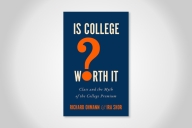You have /5 articles left.
Sign up for a free account or log in.
There’s nothing like a juicy academic scandal to get the fall semester off to an exciting start, and this year’s hot story is what newspapers and blogs are calling the “Harvard Cheating Scandal.” This story is so big that it’s eclipsed the Twilight cheating scandal. Within days of the breaking story, several of the 125 students implicated in the case began issuing anonymous statements defending themselves.
They aren’t denying the charge of cheating; their arguments are that, one, the course made them do it, and that, two, despite the fact that the final exam (available online at www.thecrimson.com) explicitly stated “[S]tudents may not discuss the exam with others,” the instructions were “confusing.”
Why was this exam, in the words of one student from “Intro to Congress,” so “blurry” and “murky,” as students told Mary Carmichael of The Boston Globe? The student’s rationale has to do with the unfortunate use of “etc.,” which appears two times in the lists of what is not permissible.
If there is one phrase that should never appear on an exam or a syllabus, it’s et cetera, for that way only danger lies. Exams have become increasingly detailed and fraught -- for the ones creating them.
That is why my exam instruction sheets have grown in length to well over a single-spaced page (not including the rubric -- a separate full-length page), with reminders to a 300-level class of English majors to “Provide a clear thesis statement! Remember that specific supporting evidence will make your argument stronger! Cite all class and outside sources using MLA format!" In other words, leave nothing to chance -- or to possible future litigation. Those instruction sheets are downright brief, however, compared to the syllabuses that I produce for the start of each semester. The Harvard situation has also raised the specter of the inadequate syllabus; at eight pages, the “Intro to Congress” syllabus is now being found lacking.
The syllabuses that I received as a graduate student rarely reached two pages. There were none for my courses in undergraduate school. At some point during a session, the professor would announce the reading for the next class or inform us that a paper would be due in two weeks or four weeks. This last announcement might be accompanied by a few notes jotted on the blackboard — a far cry from contemporary syllabuses, however, which are required and which tend to be long. Very long.
On the subject of attendance, here is the 1976 version from the first syllabus that I designed, as a graduate teaching assistant for a freshman English class:
Attendance: Attendance is required. You are allowed two absences.
Here is the 2012 version from my seven-page syllabus (not my longest effort -- I once actually produced an 11-page syllabus):
Attendance Policy: Students are expected to attend class regularly [should you attend class, you will hear my lecture on avoiding passive voice]. If you must miss a class, please make certain that I have any work that is due on that date. You are allowed two absences. This includes medical and sports absences, so plan your cuts carefully. [I repeat:] More than two absences will affect your final grade. For each additional absence, you will lose 1/3 of a letter grade; thus, if your course average is a “C” and you have three absences, your final grade for the course will be C-. Five absences will result in a grade of F. Excessive lateness (more than 20 minutes) and early departures will count as absences. If you think that you will have a serious time conflict, please let me know in the first days of the semester.
One reason for syllabus inflation might be the ease of technological production. Released from the tyranny of the typewriter and (shudder) the mimeograph machine, it is possible for syllabus-crafters to go on and on. Of course, the new order of the syllabus is clearly related to the relentless churning of assessment materials. (Meanwhile, assignments have shrunk: that first course of mine required seven papers; now I ask for five papers in writing-intensive classes. The length of a syllabus seems inversely proportional to the amount of work demanded.)
The expanded syllabus is also an attempt to anticipate any and all possible complaints and/or lawsuits from disgruntled students/disgruntled students’ parents that might arise during or after the semester. Some items are suggested or even mandated by colleges; others grow out of faculty members’ experiences. The result is one more bloated “document” whose tone veers from kindness (“Please note the following assignments”; “Please let me know...”) to alarming game-show-host exuberance (“Welcome to English 200!”) to equally frightening faux-legalism (lists of outcomes and goals; a “matrix” of the “relation of assessment to outcomes and goals”; and policies on everything from plagiarism to snow days).
It’s easy to become lost in the production of course syllabuses: with the word-count of a novella, the syllabus takes on a life of its own. There’s a sort of magical thinking, or madness, that flourishes, as in the belief that this time I will create the perfect syllabus, which will guarantee perfect performances by perfect students. And surely this time I have anticipated every single question -- I have taken care of every single thing that can go wrong (“A late entrance of more than 20 minutes will count as an absence”; “The work that you produce for this course must be new work -- it may not be work that you have produced for another course”; “Simply copying someone else’s blog entry is plagiarism”; “I will personally contact you if class is canceled because of a natural disaster.”)
As I was finishing up my syllabus for the college where I now work as an adjunct, I asked my husband, “Should I include a note saying that no animals were harmed in the making of this syllabus?”
“You can’t,” he said. “Don’t you remember how you made the cat wait outside the door and how you yelled at him through the window?”
“I wasn’t myself,” I told him. “You know I was dealing with an especially tricky part of the information section on cell phone use.”
The resulting “document” seems closer to a mutual-fund prospectus than to an introduction to a college class. But it’s a vicious cycle. If we deliver any less than what we do now, our postmodern students, acclimated to having every concern handled for them, will add that to their list of grievances. As for the Harvard situation, perhaps the best resort would be to require the offending students to take a make-up oral exam; an ad hoc committee might want to start crafting the test instructions now.








